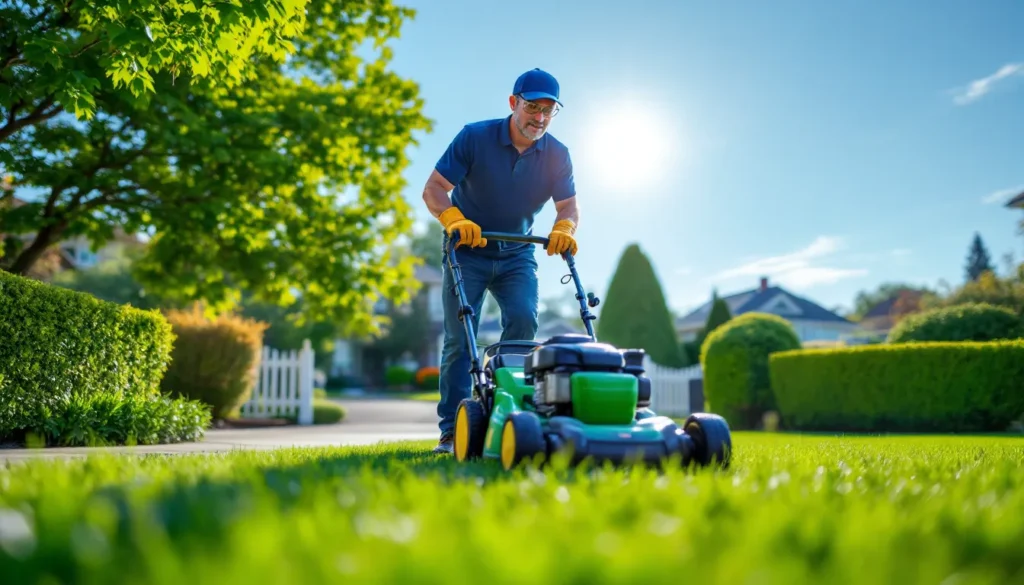Mowing your lawn might seem like a simple chore, but it’s more than just cutting grass. It’s an essential part of lawn care that helps keep your yard healthy and looking its best. Whether you’re a seasoned pro or a first-time homeowner, understanding the right techniques can make a world of difference.
Tools Needed for Mowing a Lawn
Mowing a lawn requires specific tools to ensure efficiency and safety. Familiarizing yourself with these tools enhances your mowing experience and the quality of your lawn.
Lawn Mower Types
- Push Mowers: Ideal for small to medium lawns, push mowers require physical effort for operation. They come in reel and rotary types, with reel mowers excellent for fine grasses.
- Self-Propelled Mowers: Best for larger lawns, self-propelled mowers move forward without extra effort. Models vary with front-wheel and rear-wheel drive options, catering to different terrains.
- Riding Mowers: Appropriate for expansive areas, riding mowers offer comfort and speed. They include lawn tractors and zero-turn models, with zero-turn mowers providing enhanced maneuverability.
- Robotic Mowers: Innovative and time-saving, robotic mowers autonomously maintain grass height. They feature programmable settings, making them ideal for tech-savvy homeowners.
Safety Equipment
- Gloves: Use gloves to protect your hands from sharp blades and potential injuries. Heavy-duty options provide grip and durability.
- Safety Glasses: Wear safety glasses to shield your eyes from debris propelled by the mower blades. Look for impact-resistant lenses for optimal protection.
- Ear Protection: Use ear protection to prevent hearing damage from loud mower operations. Earplugs or noise-canceling headphones offer effective sound reduction.
- Sturdy Footwear: Choose closed-toe shoes with good traction to maintain stability while mowing. Avoid sandals or flip-flops for safety reasons.
- Long Pants and Sleeves: Wear long pants and sleeves to protect your skin from cuts and abrasions. Lightweight, breathable materials ensure comfort during warmer months.
Preparing Your Lawn

Preparing your lawn before mowing is essential for achieving optimal results. Proper preparation ensures a healthy cut and minimizes damage to both your mower and grass.
Clearing Debris
Clear debris from your lawn prior to mowing. Remove branches, twigs, leaves, and any other obstacles that could obstruct the mower. Remove toys, hoses, or garden tools scattered across the grass. Not only does this enhance mower efficiency, but it also prevents potential hazards during mowing.
Choosing the Right Time
Choose the right time for mowing to ensure a clean cut. Mow when the grass is dry, typically in the late morning after the dew has evaporated. Avoid mowing during the hottest part of the day, as this can stress the grass. Opt for a calm day to minimize grass clippings being blown away, ensuring an even cut.
Mowing Techniques
Mowing techniques play a critical role in maintaining a healthy lawn. You’ll want to consider grass cutting height and mowing patterns to achieve the best results.
Grass Cutting Height
Maintaining the correct grass cutting height promotes a healthy lawn. Aim to cut no more than one-third of the grass height in a single mowing session. For most grass types, a height of 2.5 to 4 inches is ideal. Adjusting the mower blades before each cut can ensure consistent height. Taller grass retains moisture better and develops deeper roots, while cutting too short can stress the grass and encourage weed growth.
Mowing Patterns
Using different mowing patterns prevents soil compaction and encourages upright grass growth. Change your mowing direction each time you mow; alternate between vertical, horizontal, and diagonal patterns. This practice helps prevent ruts and ensures even cutting. Additionally, mow in the direction of the grass blades which can enhance the cutting effectiveness. For larger lawns, you may consider mowing in stripes to create an appealing appearance.
Maintaining Your Lawn
Maintaining your lawn ensures it remains healthy and visually appealing. A combination of regular mowing and additional care practices promotes overall lawn health.
Regular Mowing Schedule
Establish a consistent mowing schedule to support healthy grass growth. Mow every 1 to 2 weeks during the growing season, adjusting frequency based on rainfall and temperature. Maintain your mower’s sharp blades, cutting grass evenly and cleanly. Grass should always be dry during mowing to prevent clumping and ensure a precise cut. Monitor the height, aiming for a maximum of one-third of the grass height per session to encourage deeper root systems.
Additional Lawn Care Tips
Incorporate these additional tips to enhance your lawn’s health:
- Fertilization: Apply a balanced fertilizer every 6 to 8 weeks, targeting peak growing seasons for your grass type.
- Watering: Water deeply and infrequently, providing about 1 inch of water weekly, including rainfall.
- Weed Control: Manage weeds promptly to prevent competition for nutrients. Hand-pull or use appropriate herbicides based on the type of weeds present.
- Aeration: Aerate your lawn annually to improve soil compaction and nutrient absorption.
- Mulching: Consider mulching grass clippings to return nutrients to the soil and reduce the need for additional fertilizers.
These practices contribute to a thriving lawn, making your outdoor space enjoyable and attractive.
Conclusion
Mowing your lawn isn’t just about aesthetics; it’s a vital part of maintaining a healthy outdoor space. By following the right techniques and using the appropriate tools you can ensure your lawn thrives. Remember to prioritize safety and prepare your yard before you start mowing.
Establishing a regular mowing schedule and keeping your mower in top shape will make a noticeable difference. With these practices in place you’ll enjoy a lush and vibrant lawn that enhances your home’s curb appeal. Embrace the art of mowing and watch your lawn transform into a beautiful oasis.

Hi, I’m Md Rofiqul, a gardening enthusiast who loves spending time in the garden and backyard. I enjoy caring for plants, growing flowers and vegetables, and creating a green space that feels peaceful and refreshing. Gardening is more than just a hobby, it’s a passion that connects me to nature and brings joy to my daily life. Living with plants inspires me to embrace simplicity, patience, and sustainability while making every day more colorful and rewarding.
